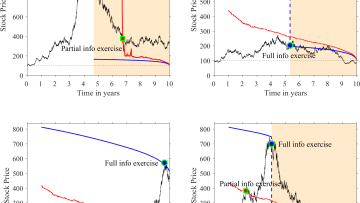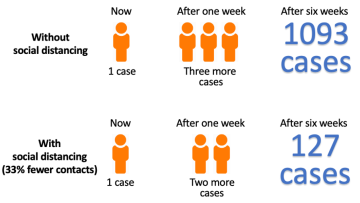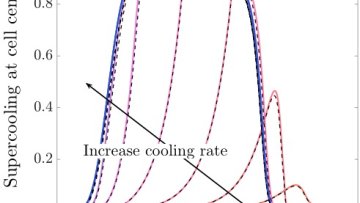Executive stock options (ESOs) are contracts awarded to employees of companies, which confer the right to reap the profit from buying the company stock (exercising the ESO) at or before a fixed maturity time $T$, for a fixed price specified in the contract (the strike price of the ESO). ESOs are used to augment the remuneration package of employees, the idea being to give them an incentive to boost the company's fortunes, and thus the stock price, making their ESO more valuable.
Social distancing measures to reduce the spread of the novel coronavirus are in place worldwide. These guideline are for everyone. We are all expected to reduce our contact with others, and this will have some negative impacts in terms of mental health and loneliness, particularly for the elderly and other vulnerable groups. So why should we follow measures that seem so extreme? The answer is simple. Social distancing works. It reduces transmission of the virus effectively and lessens the impact on already stretched healthcare services.
Oxford Mathematician Konstantin Ardakov has been awarded the 2020 Adams Prize. The Adams Prize is awarded jointly each year by the Faculty of Mathematics, University of Cambridge and St John’s College, Cambridge to UK-based researchers, under the age of 40, doing first class international research in the Mathematical Sciences.
Oxford Mathematician Mohit Dalwadi talks about his work on the modelling of cryopreservation.
The University has announced numerous steps to prioritise the health and welfare of staff, students and visitors in the light of the UK’s escalating coronavirus situation. This is an unprecedented and challenging time for our university and department community, and I would ask that you please support each other wherever you can, and follow University guidance, which is continuously updated. MI staff and students should also check their emails regularly for further guidance.
Oxford Mathematicians Derek Moulton and Alain Goriely together with their colleague Régis Chirat (University of Lyon) have won the 2019 PNAS Cozzarelli Prize in the Engineering and Applied Sciences category for their paper 'Mechanics unlocks the morphogenetic puzzle of interlocking bivalved shells.'
Multi-Objective Resource Allocation for Cognitive Radio Networks (An Exercise in Study Group Management)
Abstract
In this talk we will discuss a problem that was worked on during MISGSA 2020, a Study Group held in January at The University of Zululand, South Africa.
We look at a communication network with two types of users - Primary users (PU) and Secondary users (SU) - such that we reduce the network to a set of overlapping sub-graphs consisting of SUs indexed by a specific PU. Within any given sub-graph, the PU may be communicating at a certain fixed frequency F. The respective SUs also wish to communicate at the same frequency F, but not at the expense of interfering with the PU signal. Therefore if the PU is active then the SUs will not communicate.
In an attempt to increase information throughput in the network, we instead allow the SUs to communicate at a different frequency G, which may or may not interfere with a different sub-graph PU in the network, leading to a multi-objective optimisation problem.
We will discuss not only the problem formulation and possible approaches for solving it, but also the pitfalls that can be easily fallen into during study groups.









